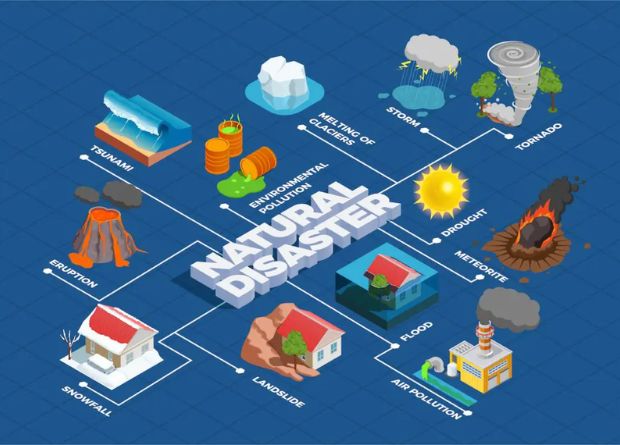Natural disasters are unpredictable—and when they strike, the aftermath can be financially devastating. From floods and earthquakes to hurricanes and wildfires, the damage to homes, vehicles, and personal property can cost thousands or even millions. That’s where insurance comes in. But not all policies are created equal, and many people find out too late that they weren’t adequately covered.
This beginner-friendly guide will walk you through what disaster insurance covers, what it doesn’t, and how you can make sure you’re truly protected.
What Is Natural Disaster Insurance?
Natural disaster insurance refers to insurance policies that cover damage caused by environmental catastrophes. While many homeowners or renters assume their regular insurance covers all disasters, that’s not always the case.
Depending on your country and insurer, you may need to buy separate policies or additional riders for specific disasters like floods or earthquakes.
Commonly Covered Disasters:
-
Fire and lightning
-
Windstorms and hail
-
Volcanic eruptions (in some cases)
-
Snow or ice damage
Often Not Included in Basic Coverage:
-
Floods
-
Earthquakes
-
Landslides
-
Tsunamis
-
Hurricanes (wind damage may be covered; storm surge might not)
Key Types of Disaster Insurance Coverage
1. Homeowners Insurance
Most standard homeowners policies will cover damage from fire, wind, hail, and lightning. However, floods and earthquakes are typically excluded and require separate coverage.
2. Flood Insurance
Flooding is one of the most common and costly disasters, but it’s rarely included in a standard policy. In the U.S., you can purchase a separate policy through the National Flood Insurance Program (NFIP), or through private insurers.
3. Earthquake Insurance
Earthquake insurance can be bought as an add-on in places like California, Japan, or Turkey where seismic activity is common. It covers:
-
Damage to your home’s structure
-
Personal belongings
-
Additional living expenses if you’re displaced
4. Renters Insurance
Renters insurance may cover some natural disaster-related damages to personal belongings, but not the building itself. Like homeowners insurance, flood and earthquake coverage usually require separate policies.
5. Auto Insurance
Only a comprehensive auto insurance policy covers natural disasters. If your car is damaged by flooding, falling trees, or hail, you’ll only be reimbursed if you have this type of coverage.
What’s Usually Not Covered?
Even with disaster-specific insurance, some losses may not be covered:
-
Gradual damage (e.g., mold or rot after flooding)
-
Lack of maintenance
-
Pre-existing structural weaknesses
-
Power outages
-
Temporary relocation beyond the allowed limit
Insurers also have deductibles and coverage limits, meaning you’ll be responsible for a portion of the costs.
How to Check If You’re Covered
It’s important to review your policy annually or whenever you move or make significant home upgrades.
Ask yourself:
-
Do I live in a flood-prone or earthquake-prone area?
-
Does my current insurance policy include those risks?
-
Do I understand what is and isn’t covered?
-
Have I updated the value of my belongings and property?
If you’re unsure, speak directly with your insurance agent and request a detailed breakdown of your coverage. For those in the U.S., you can also use the FEMA Flood Map Service to assess your flood risk.
Real-World Examples
Example 1: Hurricane Damage in Florida
In 2022, a homeowner in Miami assumed their policy covered all hurricane-related damage. However, while wind damage was included, their policy excluded flooding caused by storm surge. Without flood insurance, they had to pay over $40,000 out of pocket.
Example 2: Earthquake Loss in Turkey
After a 7.8 magnitude earthquake struck Turkey in 2023, only 50% of affected homeowners had earthquake insurance. Those without it struggled to rebuild, while insured individuals received housing compensation and rebuilding funds through DASK, Turkey’s compulsory earthquake insurance program.
How to Prepare Your Policy for Natural Disasters
✅ 1. Conduct a Risk Assessment
Check whether your home is in a disaster-prone area. You can use resources like:
✅ 2. Document Your Assets
Take photos and make an inventory of your belongings. Keep digital copies of receipts for high-value items.
✅ 3. Update Coverage Regularly
Your needs change over time. Ensure your coverage reflects new renovations, purchases, or changes in risk.
✅ 4. Consider Add-ons and Riders
Add earthquake or flood coverage if your area is at risk. Some insurers also offer “umbrella coverage” for expanded protection.
✅ 5. Compare Providers
Use comparison sites like Policygenius or NerdWallet to find insurers with disaster-specific coverage options.
Global Trends in Disaster Insurance
-
Climate change is increasing the frequency and intensity of natural disasters, leading to rising premiums and more exclusions.
-
Insurtech startups are using AI and satellite data to assess risks more accurately and offer on-demand disaster coverage.
-
Some governments, like the World Bank’s Disaster Risk Financing, are collaborating with insurers to create pooled risk solutions for vulnerable communities.
Also Check
- Cyber Insurance: Protecting Your Digital Assets in the Modern Age
- Pet Insurance Demystified: Is It Worth the Investment?
- Navigating Insurance for Freelancers: Essential Coverage Tips
Conclusion
Understanding insurance for natural disasters isn’t just about reading your policy—it’s about knowing your risks, asking the right questions, and planning ahead. Disasters can’t be predicted, but your financial response to them can be.
Whether you’re a homeowner, renter, or small business owner, now is the time to make sure you’re truly covered.
Useful External Resources:
